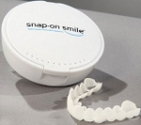Snap On Smile - An Affordable Dental Solution For Imperfect Teeth

Meet the Snap On Smile - a thin, flexible, resin shell of perfect teeth that snaps over your actual teeth like a retainer. No adhesive, no drilling.
In 2004, Dr. Marc Liechtung, a cosmetic dentist in New York, introduced the Snap on Smile. This appliance is made of a strong and durable crystallized acetic resin. It was designed to provide a temporary solution for people wanting that "Hollywood Smile", yet unable to afford the more costly veneers. The Snap-on Smile offers patients with tooth imperfections a solution that suits their lifestyle. Watch him explain the appliance in the video below.
Dr. Liechtung and The Snap on Smile |
Patient Testimonial |
If you don't particularly like the shape of your teeth or are missing teeth, you have two options. One, is to go a cosmetic dentist and have undergo traditional dental treatment with implants and veneers. The other is to consider getting the less inexpensive Snap-on Smile. While cosmetic dentistry can provide both treatment for tooth imperfections and total oral care management, the costs can be astronomical. And if the patient is financially restrained, this new device is considered an ideal alternative.

Traditionally, veneer implants require several visits office visits and, depending on the condition of the patients mouth, can run from several weeks to several months of care. And while permanent or removable veneers are more natural and can last a long time, problems can develop. The Snap-on Smile device is similar to a removable veneer that offers you a great smile at a very affordable price.

|
Since its introduction, the Snap-on Smile has caught the eye of millions. It helped revolutionize cosmetic dentistry. But, before having the appliance made, a consultation and treatment plan with a cosmetic dentist is a must to determine a persons suitability for the appliance. Its also important for dentists to offer the Snap On as a viable alternative. But, cosmetic dentistry should never be compromised with the Snap-on Smile device. Treating the root of dental problems should always the primary concern for both the patient and dentist. |
